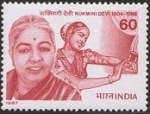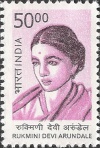Rukmini Devi Arundale
Early years
Rukmini Devi was born on February 29, 1904, into a Brahmin family in the city of Madurai, South India. Her father, Sr, A. Nilakanta Sastri of Thiruvisanellur, was an engineer and a respected Sanskrit scholar. His wife, Srimati Seshammal,came from a very cultured family of Thiruvaiyar.[1] They were "strongly influenced by theosophical ideas to which they had been introduced in 1901. When her father retired, he settled in Chennai close to the headquarters of the Theosophical Society.” [2]
Marriage
On April 27, 1920 the 16-year-old girl married Dr. George S. Arundale, a 44-year-old Englishman who was a Theosophist prominent in Indian education at Central Hindu College. It was said to be a spiritual marriage, intended as a challenge to the caste system. The ceremony was conducted by Alladi Mahadeva Shastri.[3] Rukmini and her family were ostracized by their Brahmin associates, but with support of Theosophists, the Indian public eventually adjusted to the marriage.
Theosophical Society
Rukmini joined the Society shortly after her marriage, in June, 1920. In 1923, she became the President of the All India Federation of Young Theosophists, and in 1925 the President of the World Federation of Young Theosophists.
As wife of George Arundale, Rukmini Devi would have been notable in the Theosophical Society even if she had not been such a strong and unique person in her own right. She accompanied her husband on many of his lecture tours around the world, and was acclaimed as a speaker and dancer everywhere. Dr. Arundale assumed the Presidency in1933, and continued in this role until his death in 1945. Rukmini was only 39 years old when he died. They had shared an interest in young people and education.
Introduction to dance
During a 1926 ocean journey to Australia, the Arundales met Ann Pavlova, the great Russian ballerina, and struck up a friendship. Pavlova taught Rukmini ballet movements, and encouraged her to dance, not only in ballet, but in the classical tradition of India. Rukmini Devi became interested in a dance, the “Sadir attam,” that was performed by a class of dancing girls who were widely viewed as disreputable. She could see beyond the tacky costumes and vulgarity of the dance to its inner beauty. Since women of her caste were never permitted to associate with the dancers, it took considerable effort for her to find someone who could teach her. However, she did learn the movements and refined the dance, bringing it closer to its original artistic form under the name “Bharathanatyam.”
Her first public performance was at the Diamond Jubilee Convention of the Theosophical Society. (TOS)
Kalakshetra
In 1936, the Arundales founded the International Academy of the Arts, now known as Kalakshetra.
She continued to development dances representing the Ramayana and other classical texts of India to bring forth their spiritual concepts. Every detail was scrupulously researched, to achieve a sense of authentic Indian culture…………………. Costumes, stage settings, language, and music all received her attention…………… aesthetic.
More about Kalkshetra in a separate article………………….. In 1994 an Act of the Indian Parliament recognized the Kalashetra Foundtion as an ‘Institute of national Importance.’ (TOS)
Radha Burnier was the first graduate of the school, and Sarada Hoffman was the second.[4]
World-Mother
In much the same way that Jiddu Krishnamurti was proclaimed to be the World Teacher by Annie Besant and Charles Leadbeater,
Political activities
From 1952 to 1962, Rukmini was a member of the Upper House of the Indian Parliament. She was instrumental in passing the Prevention of Cruelty to Animals Act of 1960 and for later setting up the Animal Welfare Board o f India.[5]
She was well acquainted with Indian Prime Ministers Indira Gandhi, Morarji Desai, and Rajiv Gandhi. Mr. Desai offered to nominate her for the post of President of India in 1977, but she declined.
Crafts Council of India
From 1975 to 1986, Rukmini served as President of the Crafts Council of India, a nonprofit organization supporting the education of young people in traditional Indian crafts such as stone carving, pottery, and textiles. Her many other commitments prevented her from participating in the day-to-day operations of the organization, but she provided guidance, advice, and encouragement to .[6]
Animal welfare work
According to the Theosophical Order of Service:
Rukmini Devi was committed to improving the welfare of animals in India and worked tirelessly to promote an awareness of the sanctity of all life. She wrote and spoke regularly about animal welfare, saying that we need to be the voices of those who cannot speak for themselves…. She was instrumental in establishing the legislation for The Prevention of Cruelty to Animals Act, 1960 and for later setting up the Animal Welfare Board o f India.[7]
Indian Vegetarian Congress
The Indian Vegetarian Congress was founded by Rukmini in 1959, and she served as President for many years. The organization encourages vegetarianism by”[8]
Famous friends and connections
Dr. Maria Montessori ...
‘’’Peter Finch’’’, the famous British, was close to Rukmini in his youth. His wife wrote,
When he had been a child,he had been abandoned in Madras in India, in the charge of a grandmother whose sole interest was the Theosophical Society. She lived near a temple, attended meetings with Annie Besant, was a disciple of Krishnamurti.
Peter had been brought there and lived amongst the Buddhist monks. His head was shaven, he was dressed in a saffron robe and daily, went as other monks, did, begging for his food from door to door. Rukmini was then a young woman, living near the temple. She was appalled at his condition, angered at his neglect. She adopted him into her family. She fed him made him wash, and speaking English, undertook his spiritual education. He looked upon her as a mother, attached himself to her and loved her as he had never loved his real mother.[9]
Awards and honors
India Today includes Rukmini Devi Arundale in the list of "100 People Who Shaped India" that was featured its Millenium Edition. [10]
The nation of India has commemorated her by issuance of stamps in 1987, shortly after her death, and again in 2009. The 2009 stamp was one of a series of 12 dedicated to India's "Nation Builders."
A Rukmini Devi Museum has been established at Kalakshetra to display a large number of art objects collected by Rukmini and her brother Yagneswara Shastri, and a collection bequeathed to her by Theosophist James Cousins.[11]
Indira Gandhi presented the “Desikottama” Award of the Viswabharati University.[12] In 1984, the World Vegetarian Congress awarded her The Mankar Trophy to recognize her services to the cause of vegetarianism.
“She received numerous awards for her animal welfare work, including Prani Mitra, Friend of All Animals, from the Animal Welfare Board of India, the Queen Victoria Silver Medal from the Royal Society for the Prevention of Cruelty to Animals, London, and was listed on the roll of honour by the World Federation for the Pretection of Animals, The Hague.”[13]
A Rukmini Devi Medal for Excellence in the Arts has been awarded by by the Centre for Contemporary Culture, New Delhi since 2001.
Writings
Over 100 articles in Theosophical periodicals 2 Adyar pamphlets: Theosophy as Beauty Message of Beauty to Civilizations Pamphlets My Theosophy Dance and Music Art and Education The Creative Spirit Yoga: Art or Science Woman as Artist The Teacher and the Pupil
Final days
Beginning on December 16, 1985, the Kalakshetra School began six weeks of celebration for its Golden Jubilee. Rukmini Devi was frail, but worked indomitably so that no one knew how ill she was. Her passing came as a great shock. “Crowds had gathered with garlands and wreaths to pay their last respects. The Governor, Ministers of States and other prominent citizens of Madras all came to pay their homage for truly she was a woman whose passing the whole country mourned. As a singular mark of respect, homage was paid to her in the Tamilnadu [state] Assembly which stood in silence.” .[14] The Kalakshetra artists chanted bhajans and prayers continuously.
Funeral rites were simple. A brief Christian memorial service was attended by close family and friends at Arundale House, conducted by John Clarke. In the Hindu tradition, a 10th Day ceremony was held. It included reading of excerpts from the Taittareya Upanishad and bhajans sung by Sridevi Mehta. [15]
Notes
- ↑ Joseaph E. Ross, Spirit of Womanhood, privately published by the author, 2009.
- ↑ Theosophical Order of Service, TOS In-Touch.online www.international.theoservice.org/e-news/20/en20-02.html No. 20 (February 2012), accessed February 28, 2012.
- ↑ ”Sarada Hoffman,” KutcheriBuzz Website www.kutcheribuzz.com/features/interviews/sarada.asp, accessed February 28, 2012.
- ↑ ”Sarada Hoffman,” KutcheriBuzz Website www.kutcheribuzz.com/features/interviews/sarada.asp, accessed February 28, 2012.
- ↑ TOS………..
- ↑ Radha Menon, “Homage to Rukmini Devi,” ’’Kalakshetra News, Golden Jubilee Year: Rukmini Devi Memorial Issue’’(1986), 23.
- ↑ TOS………..
- ↑ Indian Vegetarian Congress Website http://www.vegcongress.org/, accessed February 29, 2012.
- ↑ Tamara Finch, “Unexpected Phone Call,” ‘’Kalakshetra News, Golden Jubilee Year: Rukmini Devi Memorial Issue’’ (1986), 32.
- ↑ N. Pattabhi Raman, "Rukmini Devi:Czarina of Dance," India Today Millenium Edition (2000), available online at iToday Website [1], accessed March 1, 2012.
- ↑ Rukmini Devi Museum Website http://www.kalakshetra.net/rukminidevi_museum.html.
- ↑ ’’Kalakshetra News, Golden Jubilee Year: Rukmini Devi Memorial Issue’’(1986), 18.
- ↑ TOS….
- ↑ Shakuntala Ramani, “O Shining Light,” ‘’Kalakshetra News, Golden Jubilee Year: Rukmini Devi Memorial Issue’’ (1986), 11.
- ↑ ibid, 11.
Additional Resources
Crafts Council of India Website http://www.craftscouncilofindia.org/. Indian Vegetarian Congress Website http://www.vegcongress.org/. Kalakshetra Website http://www.kalakshetra.net/.

